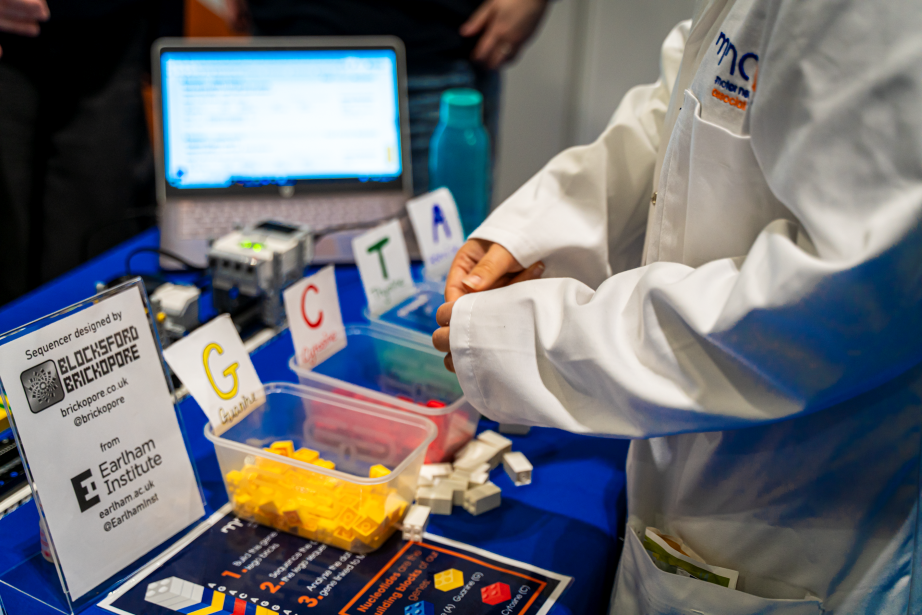In around 10% of MND cases, there is a family history of the disease. Changes in genes which can cause MND are passed down through families.
Visitors to the stand were able to explore gene sequencing (finding out whether a gene has a change that could cause MND), using our Lego gene sequencer designed by Blocksford Brickopore from the Earlham Institute. They built 'genes' out of Lego following a 'gene recipe', then fed them through the sequencer to find out if their gene was normal or has been changed and can cause MND.
There are many genes which are known to play a role in MND. Click on each gene below to find out more about some of the most common genes linked to MND.
SOD1
Changes in the SOD1 gene account for 2 in 10 inherited MND cases. SOD1 stands for superoxide dismutase 1. The SOD1 gene carries instructions to make the SOD1 protein. The SOD1 protein is an antioxidant. Antioxidants help to break down harmful and unstable byproducts of normal cell processes, which cause damage to cells. Changes in the SOD1 gene result in a faulty SOD1 protein, which is toxic to motor neurons.
TARDBP (TDP43)
Changes in the TARDBP gene account for around 5 in 100 inherited MND cases. The TARDBP gene carries instructions to make the TDP43 protein. TDP43 stands for Transactive response DNA binding protein of 43. The TDP43 protein is involved in making other proteins. Changes in the TARDBP gene can lead to TDP43 protein being in the wrong place in the cell and forming clumps. These clumps of TDP43 protein can cause damage to the motor neurons. Clumps of TDP43 are found in the brain cells of most people with MND, even those who do not have a change in the TARDBP gene.
FUS
Changes in the FUS gene account for 5 in 100 inherited MND cases. The FUS gene carries instructions to make FUS protein. FUS stands for Fused in Sarcoma. The FUS protein is involved in making other proteins. Changes in the FUS gene can result in a faulty FUS protein, which can build up in the wrong place in the cell. This can affect the production of other proteins and cause damage to the motor neurons.
C9orf72
Changes in C9orf72 are the most common gene changes linked to MND. They account for around 4 in 10 of inherited MND cases. The C9orf72 gene carries instructions to make the C9orf72 protein. The name refers to the position of the gene on the chromosome. The healthy function of the C9orf72 protein is not yet fully understood. In MND, the changes to the gene cause a part of the instructions to be repeated. It isn’t known exactly how these repeats affect the protein. They might mean that not enough of the protein is made, or that a faulty version of the protein is produced.
Genetic Testing in MND
The lego gene sequencer demonstrates that genes can be 'read' to find out if they have been changed. This type of test can be carried out in MND clinics, to test whether a person has a changed copy of a gene linked to MND. This is called genetic testing.
If someone has a clinical diagnosis of MND, they can choose to have genetic testing whether they have a family history of the condition or not. This is called diagnostic testing. They will be advised to have genetic counselling first. Genetic testing could help a person with an MND diagnosis to find out if a known changed gene played a part in their diagnosis. This means they can find out if they are able to take part in research studies about that gene, be ready if a new treatment is developed for that gene, and could give their relatives the option for genetic testing now or in the future.
A blood sample will be taken for diagnostic testing. The sample will then go through a technique called whole genome sequencing. This will look at every gene, and find any changes in genes linked to MND and similar disorders.
A person can also have genetic testing if they have not been diagnosed with MND, but there is a known changed gene in their family. This is called predictive testing. People must have genetic counselling before predictive genetic testing. This test will look only at the gene known to be changed in the person’s affected blood relative. A negative result would mean that they do not have the changed gene. A positive result would mean that they carry the changed gene. This does not mean they will definitely get MND, but it does mean they are at higher risk of developing the condition. Predictive testing cannot predict if a person will get MND.
Gene Therapies for MND
Gene therapy is a type of treatment which tries to fix or replace a changed gene. Recently, a gene therapy for SOD1 MND has been developed, called tofersen. Tofersen stops faulty SOD1 protein, which is toxic to motor neurons, from being made. In a Phase 3 clinical trial, tofersen was found to slow the progression of SOD1 MND. You can read more about the clinical trial and the results in our research blog. You can also find out more about tofersen, and the current ATLAS clinical trial, on our treatment trials webpage.
Tofersen is currently going through regulatory processes in the UK. You can read about our recent campaign to make tofersen available for everyone who needs it, and the recent update on the Medicines and Healthcare products Regulatory Agency (MHRA) approval of tofersen for the treatment of SOD1 MND.
Therapies for other genetic types of MND are being developed. These include Ulefnerson, for FUS-MND.
